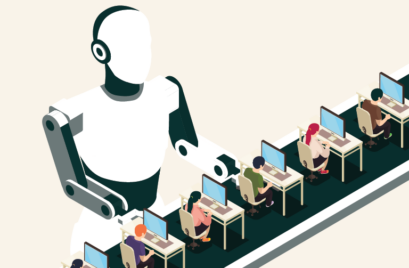
As companies rush to deploy AI in pursuit of efficiency and scale, they’re not just automating tasks, they’re redesigning how work gets done.
One way to make sense of this shift is through the lens of organisational frictions: the forces that slow, complicate, or obstruct progress. The right friction can spark better decisions or deeper trust; the wrong kind drains time, energy, and morale. The question is: can leaders tell the difference?
A Cautionary Tale from Klarna
In December 2023, Klarna, a Swedish buy-now, pay-later financing company, initiated a hiring freeze that led to its workforce dropping from 5,000 to 3,500. Remaining employees were asked to rely on AI to fill the gaps left by their departing colleagues. By February 2024, Klarna claimed that AI could handle the work of 700 customer service agents, managing
75% of the company’s customer chats, about 2.3 million conversations in over 35 languages, within the first month of launch.
By May 2025, CEO Sebastian Siemiatkowski reversed course and reintroduced human staff, citing lapses in service quality. Reflecting on the failure, he admitted: “As cost unfortunately seems to have been a too predominant evaluation factor when organising this, what you end up having is lower quality.”
This shift marks a broader inflection point for leaders: what should AI do, what should humans do, and how can they work together? This article offers a structured way to think through those questions using the concept of organisational friction.
The Lens of Frictions
Recently popularised by Bob Sutton and Huggy Rao, “frictions” refer to the forces that make it harder or more complicated to get things done. The greater the friction, the more time and/or energy required to complete a task.
Bad Friction
Drains time, energy, and morale
Examples: Bureaucratic delays, siloed systems, unclear roles
Good Friction
Enhances quality, resilience, and cohesion
Examples: Healthy debate, deep relationship-building, deliberate onboarding
It’s tempting to see friction as inherently bad: think pointless rules, endless meetings, administrative complexity, outdated systems, misalignment across teams, or corporate jargon. But frictions can also create value. Collaborative meetings, team check-ins, premortems, and retrospectives are examples of good frictions that deepen trust, enhance thinking, and strengthen decisions. Return-to-office mandates acknowledge that the frictions introduced through people being in the same location can boost collaboration and innovation, increasing business value.
AI Removes Frictions
Viewed through this lens, AI is primarily being used to eliminate friction in pursuit of business value. It streamlines routine tasks like data entry, scheduling, and reporting. AI can transcribe meetings, extract action items, and summarise discussions, easing the administrative burden on teams. It can flag supply chain bottlenecks, detect anomalies, and reduce firefighting. Costs of researching, interpreting, and generating content, whether text, images, or video, are plummeting.
Beyond automation, AI is helping organisations overcome decision-making gridlock and information silos. Intelligent search tools and knowledge platforms surface critical information faster. Some firms are even using AI to map communication patterns and reveal hidden silos, enabling structural improvements. In essence, AI is not only acceleratingwork, but making previously invisible friction points visible, so that leaders can design them out.
The Key Challenge: Identifying and Protecting “Good” Frictions
The danger lies in AI’s potential to erase not just the bad, but also the good frictions that support longer-term performance. That’s the hard lesson Klarna learned. As Siemiatkowski later acknowledged, “it’s so critical that you are clear to your customer that there will always be a human if you want.”
This statement recognises that the friction of human interaction, even if slower or more costly, can enhance customer experience and trust. So why didn’t Klarna see this earlier? Because good frictions often generate value across multiple dimensions and time horizons. Bad frictions (delays, confusion, inefficiencies) are acutely felt in the moment. Good frictions, like thoughtful debate, crossfunctional collaboration, or capability-building, tend to pay off over the long term and across multiple dimensions. They prevent costly rework, deepen engagement, and foster innovation. They make organisations more resilient.
When leaders fail to account for these layered forms of value, they risk destroying essential dynamics in their rush to optimise. Klarna’s preoccupation with cost blinded them to the value that the frictions of human connection can create.
A Frictions-Based Approach to AI Strategy
To avoid this trap, leaders should adopt a friction-conscious AI strategy. Key questions include:
- What does the current process look like?
- How might we reimagine this with the integration of AI?
- What are the bad frictions AI can reduce or eliminate?
- What good frictions might we be undervaluing, such as human connection, reflective practice, or peer learning?
A simple example is the “human-in-the-loop” model, where humans remain part of an AI system’s decision-making process; e.g., radiologists reviewing AI-generated x-rays, humans stepping in for complex customer service issues, or QA reviewers auditing AI’s defect detection. While these human roles are currently justified in terms of ensuring accuracy, over time, as AI improves there will be pressure to remove them altogether.
Our view is more expansive: organisations must consider multiple types of value (operational, emotional, relational) across multiple timeframes. Some frictions may be inefficient today, but critical tomorrow.
And the landscape is shifting. As the cost of interacting with AI drops to near-zero, the relative value of authentic human connection and creativity may rise. Conscious leaders who understand the evolving nature of friction and treat it not as something to eliminate wholesale, but as something to design intentionally, will be better positioned to build organisations that are not only faster, but wiser.
For more on how AI is impacting leadership, read more from Dr Chris Rowell:
References
https://www.livemint.com/companies/news/klarnas-ai-replaced-700-workers-now-the-fintech-ceo-wants-humans-back-after-40b-fall-11747573937564.html https://www.gsb.stanford.edu/faculty-research/books/friction-project-how-smart-leaders-make-right-things-easier-wrong-things
https://www.entrepreneur.com/business-news/klarna-ceo-reverses-course-by-hiring-more-humans-not-ai/491396







